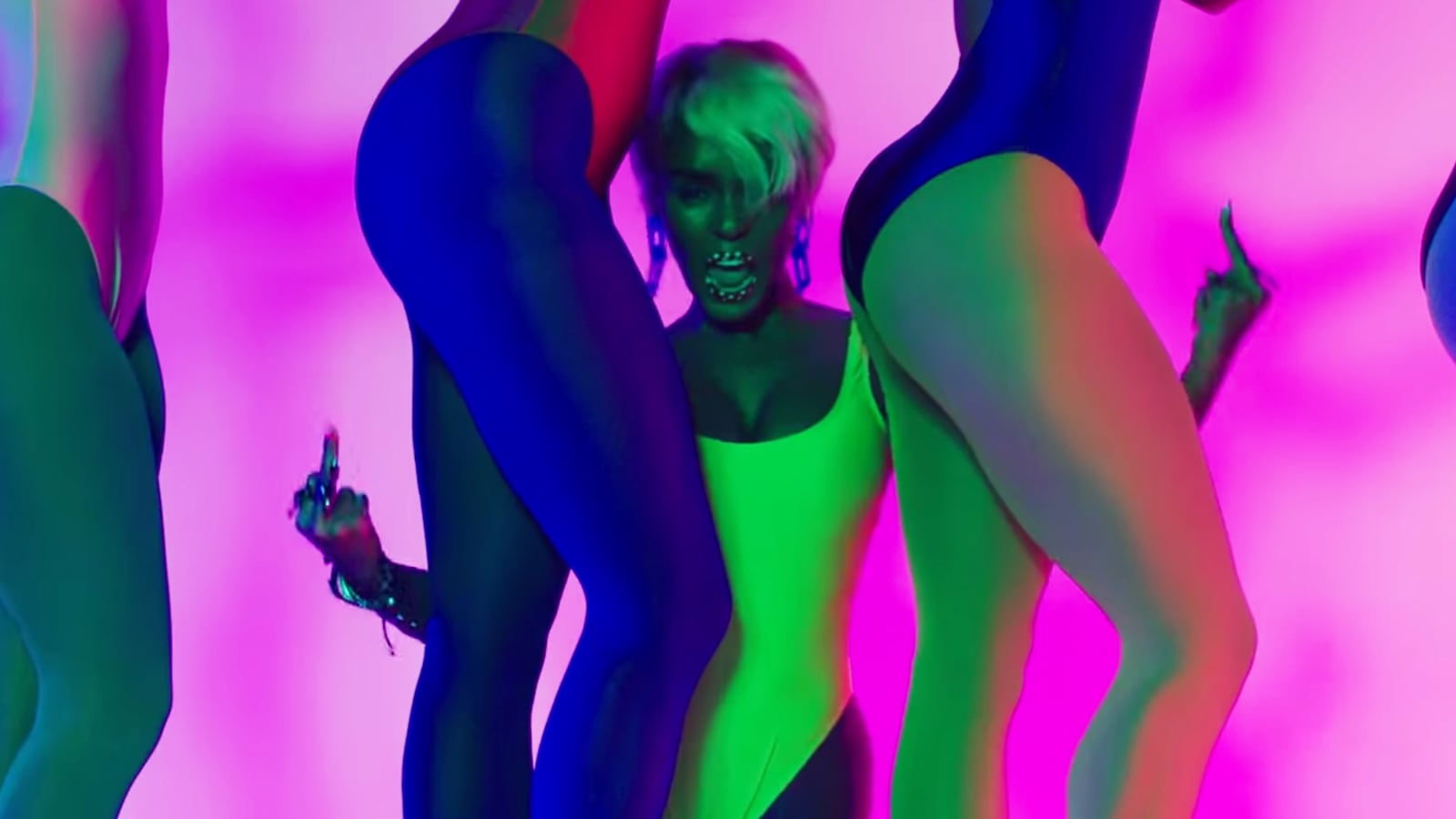Janelle Monáe, noted android and multi-hyphenate, has gifted planet Earth with a superior bisexual bop. Monáe has always been a next-level artist—like Prince, her mentor, she’s more or less on another plane.
In the music video for her new song, “Make Me Feel,” Monáe is in the best parallel universe imaginable; a soft-neon utopia of sexual fluidity, sparkly pants, and Tessa Thompson.
The video opens on Monáe and Thompson, her rumored real-life girlfriend (and star of Thor), strutting into a bar in ’80s outfits. It’s obviously a very special bar, because it’s full of David Bowie look-a-likes and a Janelle Monáe clone is performing in the back.
In a series of increasingly devastating outfits, Monáe performs her new track while simultaneously flirting with Thompson and making eyes at a hot dude (she also plays guitar in a rhinestone bikini top and does a pelvic thrust in sheer pants; the fashion in this video is as delicious as the music).
In the video’s most overtly bisexual scenes, Monáe literally ping-pongs between male and female love interests, running back and forth between Thompson and The Dude or grinding up against each of them in turn. There’s also a scene where Monáe appears to grab her own clone’s ass, which is neither here nor there but is highly relatable.
It’s no surprise that “Make Me Feel” sounds like Prince’s second coming. Monáe told The Guardian about her mentor’s influence on her new album, Dirty Computer—her first in five years. “It’s difficult for me to even speak about this because Prince was helping me with the album, before he passed on to another frequency,” she said, explaining that the pop icon was helping her “collect sounds” for Dirty Computer when he died.
“He would probably get me for cussin’, but Prince is in that ‘free motherfucker’ category,” Monáe continued, “That’s the category when we can recognise in each other that you’re also a free motherfucker. Whether we curse or not, we see other free motherfuckers. David Bowie! A free motherfucker. I feel their spirit, I feel their energy. They were able to evolve. You felt that freedom in them.”
Prince’s legacy of an androgynist robot sent down from space to make human beings horny is alive and well in Janelle Monáe.
While Prince and Bowie’s unparalleled creativity and fluidity—that freedom—left an indelible mark, Monáe is making her own history as a liberated female artist.
Very few women are allowed to maintain total creative control, and few manage to remain otherworldly.
In order to best emulate her mentor, Monáe has to work to be slightly removed, whether that means living almost exclusively in the future or evading direct questions about her personal life. In this way, she can create an artistic avatar; a mysterious, gender-blurring figure in black and white suits, operating in accordance with her own internal frequency.
In keeping with her out-of-this-world image, as well as a moment in which many are choosing expansive queerness and fluidity over traditional labels, Monáe seems happy to exist in the in-between. In 2010, Monáe told Rolling Stone, “The lesbian community has tried to claim me, but I only date androids.”
Asked again about her sexuality in a 2013 interview, Monáe said that she’s “OK with” the rumors, adding that, “People can feel free to discuss whatever it is that they think and use whatever adjectives they feel.”
In the new Guardian profile she similarly evaded the question, calling herself “sexually liberated” and reportedly refusing “to frame ‘Make Me Feel’ in literal terms.” It comes back to that freedom, the one that we so rarely allow female artists: to be an oversized creative personality, irreducible to sexual orientation or gossip, and to allow the art to speak for itself.
Of course, any queer person in the public eye feels some sort of pressure to declare themselves. “Make Me Feel” is as much about Monáe’s sexuality as it as about rumors about Monáe’s sexuality.
Early on, she croons, “Yeah, baby, don’t make me spell it out for you / You keep on asking me the same questions (why?) / And second guessing all my intentions.”
Later, Monáe sings, “It’s like I’m powerful with a little bit of tender / An emotional, sexual bender”—while crawling through a colorful lineup of women’s legs.
“No comment” has never sounded so good, or so gay. Like Bowie and Prince, you could argue that Monáe is unafraid to explore her identity in her art and her presentation. She isn’t hiding, she’s just having a conversation on her own terms, instead of bowing to the conventions of press confirmations.
In addition to being a really good song, “Make Me Feel”’s inevitable status as a bisexual anthem fills a real void. The relative lack of (mainstream) queer lady bangers—no, “I Kissed a Girl” doesn’t count—isn’t surprising.
By and large, bisexual representation in pop culture is either bad or nonexistent. According to GLAAD’s 2017-2018 report on the state of LGBTQ inclusion in TV, an “overwhelming number” of lesbian and bisexual women characters are killed off on broadcast television, in keeping with the infamous “Bury Your Gays” trope (PDF).
Unfortunately, there aren’t all too many bisexuals to kill off—of the 86 LGBTQ characters on broadcast television, 16 are bisexual women and only six are bisexual men (PDF). As the Independent pointed out, “Bisexual characters are often portrayed as promiscuous, using their sexuality in a manipulative manner to further their agenda; as untrustworthy; or even just confused. What’s more, bisexual characters are rarely given any kind of sustained exposure.”
There’s another important lack at play here, as LGBTQ characters on broadcast networks, cable, and streaming services are all over 60 percent white (PDF). According to GLAAD, only five of the 70 LGBTQ characters on the big three streaming platforms are black.
In addition to the dearth of bisexuals on TV, particularly bisexuals of color, there’s also the issue of bisexual erasure in mainstream journalism. As Samantha Allen noted last month in The Daily Beast, “As we enter 2018, the gap between an increasingly bisexual younger generation and a traditional media environment that has hardly seemed to notice them is only growing more apparent.”
In “Make Me Feel,” Monáe is serving much-needed representation just by being queer and black on camera. And the fact that the video consists of two maybe-girlfriends hanging out at a bar is a specific kind of validation—that queer women can be portrayed having a good time, as opposed to in a dramatic and potentially life-threatening story arc.
It’s nice to see a vision of queer life that, while admittedly otherworldly, is also down to earth. Thompson and Monáe’s chemistry feels real, whether or not they’re actual together, and Monáe’s playful depiction of sexual liberation is full of joy.






